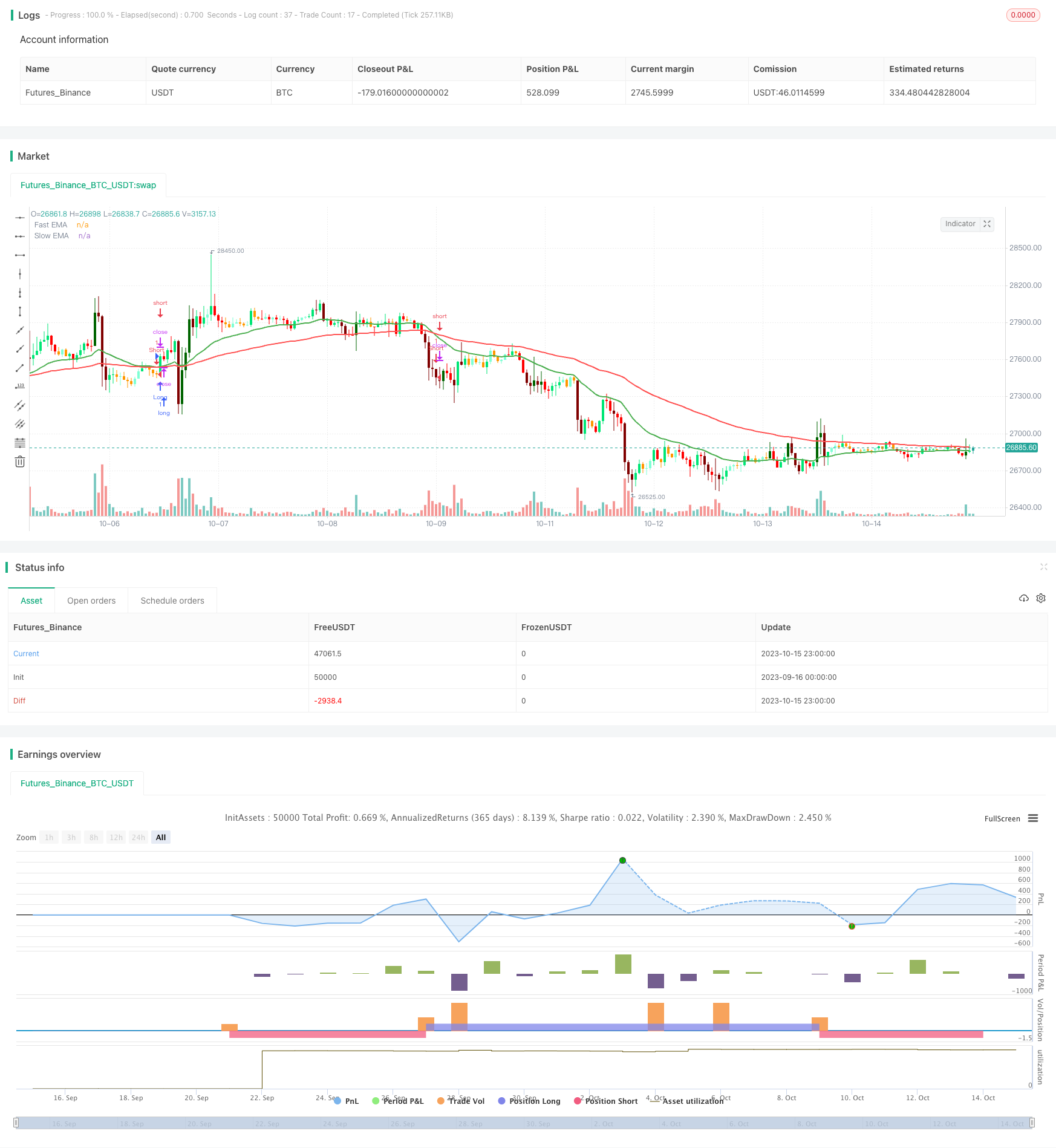
개요
이 전략은 두 개의 EMA 일률선의 황금 포크 사각형을 사용하여 입점과 출구를 판단한다. 구체적으로, 빠른 EMA 라인이 하향에서 느린 EMA 라인을 돌파 할 때 황금 포크 신호를 생성하고, 더 많이 한다. 빠른 EMA 라인이 상향에서 하향으로 느린 EMA 라인을 돌파 할 때 죽은 포크 신호를 생성하고, 공백한다. 이 전략은 간단하고 쉽게 실행되며, 매우 일반적인 거래 전략이다.
전략 원칙
이 전략의 핵심 코드는 다음과 같습니다.
fast = input(25, title="Fast")
slow = input(75, title="Slow")
matype1=ema(source, fast)
matype2=ema(source, slow)
longCondition = crossover(matype1, matype2)
shortCondition = crossunder(matype1, matype2)
if (longCondition)
strategy.entry("Long", strategy.long)
if (shortCondition)
strategy.entry("Short", strategy.short)
이 전략은 먼저 빠르게 두 개의 EMA 평균선을 설정하고, 그 중 빠른 EMA 라인의 주기가 25이고, 느린 EMA 라인의 주기가 75이다. 그리고 두 개의 EMA 라인의 값을 계산한다. 빠른 EMA 라인이 아래쪽에서 느린 EMA 라인을 뚫을 때, longCondition 조건이 참이다; 빠른 EMA 라인이 위쪽에서 아래쪽에서 느린 EMA 라인을 뚫을 때, shortCondition 조건이 참이다.
이 전략은 EMA 평균선의 평평한 특성을 활용하여 시장 노이즈를 효과적으로 필터링 할 수 있으며 동향의 변화를 빠르게 포착 할 수 있습니다. 두 개의 EMA 평균선 사이의 금색 사다리 사다리 교차는 강력한 거래 신호로 거래 위험을 효과적으로 제어 할 수 있습니다.
우위 분석
이 전략에는 다음과 같은 장점이 있습니다.
운영 방식은 간단하고 직관적이며, 이해하기 쉽다.
시장의 변동을 평형하기 위해 EMA를 사용하여 False Signal를 효과적으로 필터링하십시오.
골드 포크는 강력한 거래 신호로 위험을 효과적으로 조절할 수 있다.
다양한 시장 환경에 적용할 수 있는 EMA 주기를 유연하게 조정할 수 있다.
다른 기술 지표와 함께 쉽게 사용할 수 있습니다.
EMA 파라미터를 최적화하여 더 나은 전략 효과를 얻을 수 있습니다.
위험 분석
이 전략에는 몇 가지 위험도 있습니다.
위기상황에서 EMA가 교차하는 경우가 많아서 무효 거래 신호가 많이 발생한다.
EMA는 지연되어 있으며, 단선 기회를 놓칠 수 있습니다.
EMA 교차만으로 트렌드 전환점을 결정할 수 없으며, 일정 수익 상한이 존재한다.
고정된 EMA 주기는 시장의 변화에 적응할 수 없다.
더 많은 자금 지원이 필요합니다. 그렇지 않으면 파생의 위험이 있습니다.
단독 손실이 큰 경우, 엄격한 손해제한이 필요합니다.
최적화 방향
이 전략은 다음과 같은 부분에서 최적화될 수 있습니다.
다양한 시장 상황에 맞게 EMA 주기의 매개 변수를 최적화한다.
MACD, 브린 띠 등과 같은 다른 지표 필터를 추가하여 신호 품질을 향상시킵니다.
ATR 상쇄, ADX 등과 같은 트렌드 판단 지표를 추가하고 무효 거래를 줄입니다.
더 많은 시간 주기의 분석과 함께 추세 방향을 판단하십시오.
기계 학습 방법을 사용하여 EMA 주기를 동적으로 최적화하십시오.
포지션 관리를 최적화하여 리스크를 제어한다.
단독 손실을 줄이기 위해 손해 중지 전략을 최적화하십시오.
요약하다
이 전략은 쌍 EMA 평행선의 황금 포크 사형 포크 교차를 거래 신호로 사용하여 고전적 인 추세를 따르는 전략을 형성합니다. 이 전략은 간단하고 쉽게 작동하며 다른 기술 지표와 쉽게 결합되어 추세를 판단하는 데 필요한 인원이 많지 않은 투자자에게 적합합니다.
/*backtest
start: 2023-09-16 00:00:00
end: 2023-10-16 00:00:00
period: 1h
basePeriod: 15m
exchanges: [{"eid":"Futures_Binance","currency":"BTC_USDT"}]
*/
// This source code is subject to the terms of the Mozilla Public License 2.0 at https://mozilla.org/MPL/2.0/
// Double EMA CROSS By © EmreE (Emre Ertürk) Also thx for KivancOzbilgic color based bars
//@version=4
strategy(title="Double EMA CROSS", shorttitle="DEC", overlay=true)
matype = input("ema")
hidema = input(false)
sourcetype = input(close, title="Source Type")
source=close
// STEP 1:
// Configure backtest start date with inputs
startDate = input(title="Start Date", type=input.integer,
defval=1, minval=1, maxval=231)
startMonth = input(title="Start Month", type=input.integer,
defval=1, minval=1, maxval=12)
startYear = input(title="Start Year", type=input.integer,
defval=2020, minval=1800, maxval=2100)
// STEP 2:
// See if this bar's time happened on/after start date
afterStartDate = (time >= timestamp(syminfo.timezone,
startYear, startMonth, startDate, 0, 0))
fast = input(25, title="Fast")
slow = input(75, title="Slow")
matype1=ema(source, fast)
matype2=ema(source, slow)
signalcolor = source > matype2 ? color.blue : color.red
signal = cross(fast, slow)
hizliema=plot(hidema ? na : matype1, color=color.green, linewidth=2,transp=0, title="Fast EMA")
yavasema=plot(hidema ? na : matype2, color=color.red, linewidth=2,transp=0, title="Slow EMA")
//kesisme=plot(signal, style=cross, color=signalcolor, linewidth=5, title="Kesişme")
longCondition = crossover(matype1, matype2)
if (afterStartDate and longCondition)
strategy.entry("Long", strategy.long)
shortCondition = crossunder(matype1, matype2)
if (afterStartDate and shortCondition)
strategy.entry("Short", strategy.short)
//--------------------------------------------------------
//volume based color bars
length=input(21, "length", minval=1)
avrg=sma(volume,length)
vold1 = volume > avrg*1.5 and close<open
vold2 = volume >= avrg*0.5 and volume<=avrg*1.5 and close<open
vold3 = volume < avrg *0.5 and close<open
volu1 = volume > avrg*1.5 and close>open
volu2 = volume >= avrg*0.5 and volume<=avrg*1.5 and close>open
volu3 = volume< avrg*0.5 and close>open
cold1=#800000
cold2=#FF0000
cold3=color.orange
colu1=#006400
colu2=color.lime
colu3=#7FFFD4
ac = vold1 ? cold1 : vold2 ? cold2 : vold3 ? cold3 : volu1 ? colu1 : volu2 ? colu2 : volu3 ? colu3 : na
barcolor(ac)